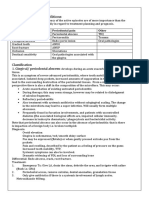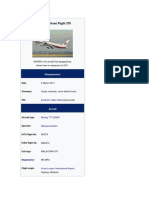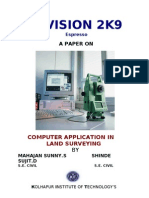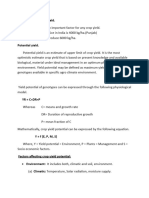Conscious Sedation in Dentistry
Conscious Sedation in Dentistry
Uploaded by
Harees ShabirCopyright:
Available Formats
Conscious Sedation in Dentistry
Conscious Sedation in Dentistry
Uploaded by
Harees ShabirCopyright
Available Formats
Share this document
Did you find this document useful?
Is this content inappropriate?
Copyright:
Available Formats
Conscious Sedation in Dentistry
Conscious Sedation in Dentistry
Uploaded by
Harees ShabirCopyright:
Available Formats
Singh N et al: Conscious Sedation in Dentistry REVIEW ARTICLE
Application of Conscious Sedation in Dentistry
Nisha Singh1, Chandan R Agali2, Ashok KN3, N Senthil Kumaran4,
6
Geetha L5, Saraswati Ghosh
1- Post Graduate student, Department of Pedodontics and preventive
dentistry, BIDSH, Patna, Bihar, India.
2- Reader, Department of Public health dentistry, TMDCRC, Moradabad, Uttar Correspondence to:
Pradesh, India. Dr.Nisha Singh,
3- Senior Lecturer, Department of Oral Medicine and Radiology, HSRSM Dental Department of Pedodontics and Preventive Dentistry, BIDSH,
College and Hospital, Hingoli, Maharashtra, India. Patna, Bihar, India.
4- Department of Pedodontics and preventive dentistry, Chettinad Dental
Contact Us: editor@ijdmr.com
College and Hospital, Chennai, India.
Submit Manuscript: submissions@ijdmr.com
5- Senior Lecturer, Department of Oral Pathology and Microbiology, HSRSM www.ijdmr.com
Dental College and Hospital, Hingoli, Maharastra, India.
6- Professor in Curriculum & Instruction, College of Education, Eritrea Institute
of Technology, Mai-Nefhi, Eritrea (Africa).
ABSTRACT
Sedation for dental procedures (with or without local anaesthesia) includes the administration by any route or technique
of all drugs which result in depression of the central nervous system. Conscious sedation is administered with an aim to
produce a degree of sedation without loss of consciousness, in order to perform a desired function without any
hindrance. This technique is being widely followed by paediatric dentists, who utilize the method on uncooperative and
anxious patients during any treatment. This technique has many adverse effects. This article reviews the various aspects
of conscious sedation in general and paediatric dentistry. ………………………………………………………………………………………………
KEYWORDS: Conscious Sedation, Anaesthesia, Dentistry……………………………………………………………
INTRODUCTION
Conscious sedation is defined as a technique in procedures are common and anaesthetists should
which the use of a drug or drugs produces a state of know what sedation techniques are effective and
depression of the central nervous system enabling likely to be used by other healthcare practitioners.
treatment to be carried out, but during which verbal Conscious sedation can be used in children
contact with the patient is maintained throughout the presenting for anaesthesia.
period of sedation.1 The various drugs and
techniques used in providing conscious sedation for GOALS OF CONSCIOUS
dental treatment should carry a margin of safety SEDATION
wide enough to render loss of consciousness
unlikely.2,3 Goals of conscious sedations are:3
Promoting patient welfare and safety.
Recently, it has been proved that conscious sedation Facilitating provision of quality care.
can be delivered using processes that have marked Minimizing the extremes of disruptive
adverse effects. These involve special sedation behaviour.
technique that risk causing unintended deep Promoting a positive psychological response
sedation. Children visiting a dentist need effective to treatment.
sedation during any minor procedure because of Returning the child to a physiological state in
fear, ill health, behavioural problems, etc. Some which safe discharge is possible.
How to cite this article:
Singh N, Agali CR, Ashok KN, Kumaran NS, Geetha L, Ghosh S. Application of Conscious Sedation in Dentistry. Int J Dent
Med Res 2014;1(4):90-93.
Int J Dent Med Res | NOV - DEC 2014 | VOL 1 | ISSUE 4 90
Singh N et al: Conscious Sedation in Dentistry REVIEW ARTICLE
Contain a clear treatment plan, completed
GERERAL PRINCIPLES OF medical history and consent form,
CONSCIOUS SEDATION appropriate radiographs and briefly give an
account of the reason for the need for
Patients should be assessed. The assessment should sedation.
3
include: Document the operative treatment that was
performed, the name of the drug,
Full medical and dental history that needs to
concentration and batch number (if
be performed before providing the treatment
appropriate), dosage, route and duration of
with conscious sedation.
sedation.
Informed consent for a course of dental
State which monitors were used (as
treatment under conscious sedation must be
appropriate) together with their readings.
obtained from patient, each parent/guardian,
Include a time-based record where
and the child, prior to the conscious sedation
appropriate.
appointment.
An explanation of the sedation technique
Training of dental staff should be done4
proposed must be given.
Before starting with the procedure, the child The dental team must undergo appropriate
and their parent or guardian must be given training on a regular basis.
clear and comprehensive pre- and It is essential that primary care dentists who
postoperative instructions in writing. sedate children undergo training that is
Fasting is not required for children recognized by appropriate authorities and
undergoing inhalation sedation using nitrous that their clinical skill and knowledge
oxide but dentists might recommend that a relating to paediatric conscious sedation,
light meal only is consumed in the two hours including local anaesthesia, behavioural
prior to the appointment management and the provision of operative
dental care for children, is regularly
Patients with serious medical complications should
updated.
be dealt with extra concern3
If the patient has any serious medical APPLICATION OF VARIOUS
condition, then they must be referred to DRUGS FOR CONSCIOUS
specialist medical practitioner before
planning for any treatment using conscious
SEDATION
sedation. If the patient is seriously medically Drug Application Drawbacks
compromised, then an anaesthetist should be Nitrous - Children with mild to - Is of less value in those
5-7 moderate anxiety to enable who require multiple
present to provide sedation and monitor the Oxide
them to accept dental extractions,
patient during the procedure. treatment better and to - Poor attenders and
facilitate coping across very young children.
A parent, legal guardian or other responsible sequential visits. - Common cold,
adult must accompany the child to and from - Can be used to facilitate tonsillitis, nasal
dental extractions in blockage are common
the treatment facility. children. - Pre-co-operative
- Is preferred to general children and women at
anaesthesia for anxious first trimester of
Documentation should be done4………………. children undergoing pregnancy are
Proper documentation of the patient should be elective orthodontic contraindicated.
(premolar) extractions.
done. this should include: - Is a cost effective
alternative to general
Name and signature of the operator together Diazepam and
anaesthesia
- Oral benzodiazepines - There is no role for
with the name(s) of the assistants. 8- can be used to relax intravenous diazepam
temazepam
10 anxious patients prior to sedation in paediatric
dental treatment but their dentistry.
Int J Dent Med Res | NOV - DEC 2014 | VOL 1 | ISSUE 4 91
Singh N et al: Conscious Sedation in Dentistry REVIEW ARTICLE
effects can be
11
unpredictable in children.
- May have a potential - Is not recommended
COMPLICATIONS
Midazolam
value as a pre-medication for use out with a
and sedative agent. hospital environment. The main complications related to conscious
Flumazenil-
12 -Reversal with Flumazenil - Flumazenil may induce sedation are : 18,19
should not be used as a
routine part of the
convulsions.
Hypoxia
conscious sedation Nausea and vomiting
Opioids and
procedure
-can be used to relax - Repeated
Inadvertent general anaesthesia (over
other anxious patients prior to administration of chloral sedation).
miscellaneous dental treatment but their hydrate carries a risk of
agents with effects can be carcinogenesis.
sedative unpredictable in children. - Fentanyl and other
properties potent opioids should MONITORING
(chloral only be used by a
hydrate, qualified anaesthetist in All patients undergoing intravenous sedation must
hydroxyzine, a hospital setting.
promethyaine
be monitored continuously and thoroughly with
hydrochloride, pulse oximetry. There must be regular record of
fentanyl &
pethidine) various vital signs like pulse rate, oxygen saturation
and blood pressure.20
ROUTES OF Hypoxemia is a major complication following
conscious sedation in paediatric patients. Traditional
ADMINISTRATION methods of monitoring sedated paediatric patients
Routes Features include visual observation of skin colour, depth and
1 13 - Recommended route for conscious sedation
Inhalation rate of respiration, listening to heart and breath
for paediatric dentistry.
- Operator should use a close-fitting sounds using a pre-cordial stethoscope.21,22
scavenging nasal hood. An air-entrainment
valve is not required.
- Efficacy is reduced when patient object to Oxygen administration reduces hypoxia during
the nasal hood or have difficulty breathing
through the nose. procedures carried out during sedation and therefore
2 14 - Prescribed and administered by the
should be readily available.23
Oral
operating dentist within the facility where
the dental procedure is to take place.
- Children who are given an oral sedative
CONCLUSION
should be placed in a quiet room facility
together with their escort and a competent The provision of adequate anxiety control is an
member of staff.
- Sedated children should be monitored integral part of the practice of dentistry. All patients
clinically and electronically. deserve appropriate anxiety control for any dental
3 Intravenous -Intravenous sedation is not recommended in
conscious pre-cooperative children. Dentists should procedure. The application of conscious sedation
15 consider whether the provision of an elective
sedation
general anaesthetic might be preferable in
should be carried out effectively and precisely so
such circumstances. that it maintains a healthy gap from general
- Single drug intravenous sedation, e.g.
midazolam, is recommended for adolescents anesthesia and unconsciousness. More concern
who are psychologically and emotionally should be taken when this process is applied on
suitable.
- Intravenous sedation should only be pediatric patients. Seditionist must be aptly trained
administered by an experienced dental to perform sedations on patients.4,18
sedationist with a trained dental nurse in an
appropriate facility.
- A pulse oximeter, at least, should be used.
4 Rectal
16 -Rectal administration is not socially REFERENCES
acceptable.
- It is currently not recommended out with a 1. Nathan JE. Management of the difficult child: a
hospital facility and requires the assistance
survey of pediatric dentists’ use of restraints,
of a qualified anaesthetist.
5 Intramuscular -This is not recommended. Operators should sedation and general anesthesia. ASDC Journal
17 consider whether the alternative provision of
sedation of Dentistry for Children 1989; 56: 293–301.
a general anaesthetic might carry a lower risk
and give greater long-term psychological 2. Roberts GJ, Brook AH, Page J, Davenport ES.
benefit to the child. British Society of Paediatric Dentistry. A policy
document on sedation for paediatric dentistry.
Int J Dent Med Res | NOV - DEC 2014 | VOL 1 | ISSUE 4 92
Singh N et al: Conscious Sedation in Dentistry REVIEW ARTICLE
International Journal of Paediatric Dentistry 14. Shapira J, Holan G, Botzer E, Kupieztky A, Tal
1996; 6: 63–66. E, Fuks AB. The effectiveness of midazolam
3. General Dental Council. Maintaining Standards. and hydroxyzine as sedative agents for young
Guidance to dentists on professional and pediatric dental patients. ASDC Journal of
personal conduct. Publisher City, Country: Dentistry for Children 1996; 63: 421–425.
Publisher, 1997; modified 1998. 15. Houpt MI. Project USAP – Part III: Practice by
4. Guidelines for the elective use of conscious heavy users of sedation in pediatric dentistry.
sedation, deep sedation and general anesthesia in ASDC Journal of Dentistry for Children 1993;
pediatric dental patients: Reference manual 60: 183–185.
1999–2000. Pediatric Dentistry 1999; 21:68–73. 16. Laskin JL, Williamson KG. An evaluation of the
5. Major E, Winder M, Brook AH, Berman DS. An amnesic effects of diazepam sedation. Journal of
evaluation of nitrous oxide in the dental Oral & Maxillofacial Surgery 1984; 42: 712–
treatment of anxious children. A physiological 716.
and clinical study. British Dental Journal 1981; 17. Rita L, Seleny FL, Mazurek A, Rabins SY.
151: 186–191. Intramuscular midazolam for pediatric
6. Veerkamp JS, Gruythuysen RJ, Hoogstraten J, preanesthetic sedation: a doubleblind controlled
van Amerongen WE. Anxiety reduction with study with morphine. Anesthesiology 1985; 63:
nitrous oxide: a permanent solution? ASDC 528–531.
Journal of Dentistry for Children 1995; 62: 44– 18. Cote CJ, Notterman DA, Karl HW, Weinberg
48. JA, McCloskey C. Adverse sedation events in
7. Parbrook GD, James J, Braid DP. Inhalational pediatrics: a critical incident analysis of
sedation with isoflurane: an alternative to nitrous contributing factors (see comments). Pediatrics
oxide sedation in dentistry. British Dental 2000; 105: 805–814.
Journal 1987; 163: 88–92. 19. Cote CJ, Karl HW, Notterman DA, Weinberg
8. Laskin JL, Williamson KG. An evaluation of the JA, McCloskey C. Adverse sedation events in
amnesic effects of diazepam sedation. Journal of pediatrics: analysis of medications used for
Oral & Maxillofacial Surgery 1984; 42: 712– sedation. Pediatrics 2000; 106: 633–644.
716. 20. Wilson S. Conscious sedation and pulse
9. Harris D, O’Boyle C, Barry H. Oral sedation oximetry: false alarms? Pediatric Dentistry
with temazepam: controlled comparison of a soft 1990; 12: 228–232.
gelatin capsule formulation with intravenous 21. Wilson S. Patient monitoring in the conscious
diazepam. British Dental Journal 1987; 162: sedation of children for dental care. Current
297–301. Opinion in Dentistry 1991; 1: 570–576.
10. Lundgren S, Ekman A, Blomback U. Rectal 22. Iwasaki J, Vann WFJ, Dilley DC, Anderson JA.
administration of diazepam in solution. A An investigation of capnography and pulse
clinical study on sedation in paediatric dentistry. oximetry as monitors of pediatric patients
Swedish Dental Journal 1978; 2: 161–166. sedated for dental treatment. Pediatric Dentistry
11. Parbrook GD, Still DM, Parbrook EO. 1989; 11: 111–117.
Comparison of i.v. sedation with midazolam and 23. Rohlfing GK, Dilley DC, Lucas WJ, Vann WFJ.
inhalation sedation with isoflurane in dental The effect of supplemental oxygen on apnea and
outpatients. British Journal of Anaesthesia 1989; oxygen saturation during pediatric conscious
63: 81–86. sedation. Pediatric Dentistry 1998; 20: 8–16.
12. Rodrigo MR, Chan L, Hui E. Flumazenil
reversal of conscious sedation for minor oral Source of Support: Nil
surgery. Anaesthesia & Intensive Care 1992; 20: Conflict of Interest: Nil
174–176.
13. Dworkin SF, Schubert M, Chen AC, Clark DW.
Psychological preparation influences nitrous
oxide analgesia: replication of laboratory
findings in a clinical setting. Oral Surgery,Oral
Medicine, Oral Pathology 1986; 61: 108–112.
Int J Dent Med Res | NOV - DEC 2014 | VOL 1 | ISSUE 4 93
You might also like
- Management of Medical Emeregency in Dental PracticeDocument51 pagesManagement of Medical Emeregency in Dental Practicechoudharyishita163No ratings yet
- Textbook of Pediatric Dentistry-3rd EditionDocument18 pagesTextbook of Pediatric Dentistry-3rd EditionAnna NgNo ratings yet
- Direct Restoration Manual 20 - 21Document130 pagesDirect Restoration Manual 20 - 21Felix WongNo ratings yet
- Brand Equity ModelDocument86 pagesBrand Equity ModelYash Vora100% (1)
- Aramco Piping QuestionsDocument6 pagesAramco Piping Questionschandu666creator90% (10)
- BEL 252 V.02: Operation & Service ManualDocument27 pagesBEL 252 V.02: Operation & Service ManualjuanNo ratings yet
- Bike Share PresentationDocument71 pagesBike Share PresentationPaul100% (2)
- Heat of Neutralization Formal ReportDocument16 pagesHeat of Neutralization Formal ReportReymar Suello Ungab100% (6)
- Conscious Sedation in Pediatric Dentistry A ReviewDocument4 pagesConscious Sedation in Pediatric Dentistry A Reviewjyothi shashidharNo ratings yet
- Dentin HypersenstivityDocument4 pagesDentin Hypersenstivitymohamed saadNo ratings yet
- Acute Periodontal Conditions: PeriodonticsDocument9 pagesAcute Periodontal Conditions: Periodonticsmonica896No ratings yet
- Endodontic MishapsDocument19 pagesEndodontic MishapsSayak Gupta100% (1)
- Management of Special ChildDocument110 pagesManagement of Special ChildRisana RahoofNo ratings yet
- Oral Diagnosis and Treatment Planning: Part 4. Non-Carious Tooth Surface Loss and Assessment of RiskDocument7 pagesOral Diagnosis and Treatment Planning: Part 4. Non-Carious Tooth Surface Loss and Assessment of Riskalfredoibc100% (1)
- Immediate DentureDocument48 pagesImmediate DenturesunithabanavathNo ratings yet
- SSCDocument50 pagesSSCMustafa Tambawala100% (1)
- Basic TxPlanning-Prognosis and Treatment Planning-Revised 9 September 2014Document54 pagesBasic TxPlanning-Prognosis and Treatment Planning-Revised 9 September 2014DraspiNo ratings yet
- DIAGNOSTIC METHODS (Emphasis On Recent Advances) IN EndodonticsDocument51 pagesDIAGNOSTIC METHODS (Emphasis On Recent Advances) IN EndodonticsKalpesh Dey100% (1)
- Prostho Prelim LectureDocument12 pagesProstho Prelim LectureChristine LomuntadNo ratings yet
- Know Your Implant Connections: April 2018Document8 pagesKnow Your Implant Connections: April 2018kavya ravuriNo ratings yet
- Treatment PlanDocument4 pagesTreatment Planapi-663973338No ratings yet
- Aberrant Frenum and Its TreatmentDocument90 pagesAberrant Frenum and Its TreatmentheycoolalexNo ratings yet
- Diagnosis and Management of Odontogenic InfectionsDocument52 pagesDiagnosis and Management of Odontogenic InfectionsAhmed Emad100% (1)
- Implant Seminar (1) Part 1Document37 pagesImplant Seminar (1) Part 1Suma TettaNo ratings yet
- Teething DisordersDocument62 pagesTeething DisordersLakshmi VamadevanNo ratings yet
- Post-Extraction Complications: Presented By, Abirami. K CrriDocument32 pagesPost-Extraction Complications: Presented By, Abirami. K Crriabi2189No ratings yet
- 11.moderate Nonskeletal Problems in Preadolescent ChildrenDocument11 pages11.moderate Nonskeletal Problems in Preadolescent ChildrenyasmineNo ratings yet
- Root Fracture and It'S ManagementDocument139 pagesRoot Fracture and It'S ManagementHema lathaNo ratings yet
- Dental Management of The Patient Undergoing Radiotherapy or ChemoterapyDocument43 pagesDental Management of The Patient Undergoing Radiotherapy or ChemoterapyJenadi Binarto100% (2)
- Caries VaccineDocument30 pagesCaries Vaccinemangesh andhare100% (1)
- Acute Pulpitis DiagnosisDocument78 pagesAcute Pulpitis Diagnosisparthasarathy R100% (1)
- Best Pharmacology-Dentistry PDFDocument30 pagesBest Pharmacology-Dentistry PDFalijanmarwat100% (1)
- Periodontal Problems in KidsDocument49 pagesPeriodontal Problems in KidsRaksmey PhanNo ratings yet
- Preventive DentistryDocument70 pagesPreventive Dentistryceudmd3d100% (1)
- Mechanism of Action of Fluoride in Dental Caries PedoDocument21 pagesMechanism of Action of Fluoride in Dental Caries PedoFourthMolar.com100% (1)
- Root Morphology ChartDocument2 pagesRoot Morphology Chartapi-444357381No ratings yet
- Mouth Props Used in Pediatric DentistryDocument13 pagesMouth Props Used in Pediatric DentistryPurva Chaudhari YelneNo ratings yet
- BY Dr. Fahd Bangash: PresentationDocument32 pagesBY Dr. Fahd Bangash: PresentationJawad Ahmad0% (1)
- Radiology in Pediatric Dentistry 2Document44 pagesRadiology in Pediatric Dentistry 2Aima Cuba100% (1)
- Components of A Complete Periodontal ExaminationDocument12 pagesComponents of A Complete Periodontal ExaminationIvan Fadhillah NurdinNo ratings yet
- Local Anaesthesia in Dentistry A ReviewDocument9 pagesLocal Anaesthesia in Dentistry A ReviewAshyana SaeedNo ratings yet
- Objective of Full Mouth RehabilitationDocument5 pagesObjective of Full Mouth RehabilitationSheeba AnilNo ratings yet
- Role of Antibiotics in EndodonticsDocument45 pagesRole of Antibiotics in EndodonticsAshutosh KumarNo ratings yet
- PRINCIPLES of Uncomplicated ExtractionDocument80 pagesPRINCIPLES of Uncomplicated ExtractionObu KavithaNo ratings yet
- Management of Physically Disabled Patient PedoDocument25 pagesManagement of Physically Disabled Patient PedoFourthMolar.com100% (3)
- Traumatic InjuriesDocument43 pagesTraumatic Injuriessandsiramesh100% (1)
- Endodontic EmergenciesDocument21 pagesEndodontic Emergencieszara khanNo ratings yet
- DentureDocument80 pagesDentureDrShweta SainiNo ratings yet
- Avulsion: DEFINITION: - Tooth Avulsion (Exarticulation) Implies Total Displacement of The ToothDocument39 pagesAvulsion: DEFINITION: - Tooth Avulsion (Exarticulation) Implies Total Displacement of The Toothshailesh_shenoyNo ratings yet
- Department of Pediatrics and Preventive Dentistry.: Local Anasthesia in Pediatric DentistryDocument27 pagesDepartment of Pediatrics and Preventive Dentistry.: Local Anasthesia in Pediatric DentistrySudip Chakraborty100% (1)
- Oral Surgery FlapsDocument13 pagesOral Surgery Flapshaneefmdf100% (1)
- Diet and Dental CariesDocument113 pagesDiet and Dental CariesShivani DubeyNo ratings yet
- Psychological Considerations For Complete Denture Patients.Document7 pagesPsychological Considerations For Complete Denture Patients.Prateek MishraNo ratings yet
- Anatomy in Dental ImplantologyDocument29 pagesAnatomy in Dental ImplantologyZiad RabieNo ratings yet
- 10 Pulp and Periapical DiseaseDocument7 pages10 Pulp and Periapical Diseasedoctorgame085100% (1)
- JISPPD Supplement 19 PDFDocument71 pagesJISPPD Supplement 19 PDFmadhu kakanurNo ratings yet
- Management of Odontogenic Infections and SepsisDocument8 pagesManagement of Odontogenic Infections and Sepsismartha carolina vargas bernal100% (1)
- Periodontal AbscessDocument27 pagesPeriodontal AbscessAhmed Tawfig GamalNo ratings yet
- HabitsDocument36 pagesHabitsMaitreyi LimayeNo ratings yet
- Space Regainers in Pediatric DentistryDocument6 pagesSpace Regainers in Pediatric DentistryDiba Eka DiputriNo ratings yet
- Medically Compromised PatientsDocument21 pagesMedically Compromised PatientsDyah Wulan Ramadhani100% (1)
- Self Applied Topical Fluorides ClassDocument23 pagesSelf Applied Topical Fluorides ClassultraswamyNo ratings yet
- Combined Dental Management of Patients With Medical ConditionsDocument65 pagesCombined Dental Management of Patients With Medical ConditionsJenny WangNo ratings yet
- Basic Level of Dental Resins - Material Science & Technology: 4th Edition, 2nd VersionFrom EverandBasic Level of Dental Resins - Material Science & Technology: 4th Edition, 2nd VersionNo ratings yet
- Psychology II 2013 KasmainsDocument2 pagesPsychology II 2013 KasmainsHarees ShabirNo ratings yet
- Teething Gel: Soothes Baby's GumsDocument2 pagesTeething Gel: Soothes Baby's GumsHarees ShabirNo ratings yet
- National Clean Air Programme: Key PointsDocument2 pagesNational Clean Air Programme: Key PointsHarees ShabirNo ratings yet
- Antimicrobials in Dentistry Seminar Jan 5Document13 pagesAntimicrobials in Dentistry Seminar Jan 5Harees ShabirNo ratings yet
- Attitude, Values & InterestDocument22 pagesAttitude, Values & InterestHarees ShabirNo ratings yet
- 45cef Ethics in Administration Concerns Dilemma and SolutionsDocument36 pages45cef Ethics in Administration Concerns Dilemma and SolutionsHarees ShabirNo ratings yet
- 3991c Ethics in Administration Sources Aptitude and Foundational ValuesDocument47 pages3991c Ethics in Administration Sources Aptitude and Foundational ValuesHarees ShabirNo ratings yet
- Conservative Management of Talon's Cusp-A Case ReportDocument22 pagesConservative Management of Talon's Cusp-A Case ReportHarees Shabir100% (1)
- Different Techniques of Enamel MicroabrasionDocument38 pagesDifferent Techniques of Enamel MicroabrasionHarees ShabirNo ratings yet
- Classical Psychoanalytical Theory Sigmund FreudDocument41 pagesClassical Psychoanalytical Theory Sigmund FreudHarees Shabir100% (1)
- Trigeminal Nerve: Presented by DR Harees Shabir JR I Departmant of PedodonticsDocument77 pagesTrigeminal Nerve: Presented by DR Harees Shabir JR I Departmant of PedodonticsHarees ShabirNo ratings yet
- Facial Nerve: BY Alvi Fatima Mds 1 Year Dept of Prevantive and Pediatric DentistryDocument69 pagesFacial Nerve: BY Alvi Fatima Mds 1 Year Dept of Prevantive and Pediatric DentistryHarees Shabir100% (2)
- A Longitudinal Observational Study of Developmental Defects of Enamel From Birth To 6 Years of AgeDocument7 pagesA Longitudinal Observational Study of Developmental Defects of Enamel From Birth To 6 Years of AgeHarees ShabirNo ratings yet
- Dental Caries Status and Its Associated Factors Among 3-To 5-Year-Old Children in China: A National SurveyDocument13 pagesDental Caries Status and Its Associated Factors Among 3-To 5-Year-Old Children in China: A National SurveyHarees ShabirNo ratings yet
- Conscious Sedation: Presented byDocument101 pagesConscious Sedation: Presented byHarees Shabir100% (1)
- An Application Framework For Smart Education System Based On Mobile and Cloud SystemsDocument12 pagesAn Application Framework For Smart Education System Based On Mobile and Cloud SystemsHarees ShabirNo ratings yet
- Stem Cells SeminarDocument65 pagesStem Cells SeminarHarees ShabirNo ratings yet
- Data OF StaffDocument2 pagesData OF StaffHarees ShabirNo ratings yet
- Malaysia Airlines Flight 370Document3 pagesMalaysia Airlines Flight 370dinosaur x-drakeNo ratings yet
- OCOC-II Live Class-1 Teacher NotesDocument41 pagesOCOC-II Live Class-1 Teacher Notesmardarchod 123No ratings yet
- Annex 21.1.1: Name of Ship Certificate No. ............... Official Number Call Sign Port of Registry Name of OwnerDocument1 pageAnnex 21.1.1: Name of Ship Certificate No. ............... Official Number Call Sign Port of Registry Name of OwnerRihardsNo ratings yet
- Irf3805Pbf Irf3805Spbf Irf3805Lpbf: FeaturesDocument14 pagesIrf3805Pbf Irf3805Spbf Irf3805Lpbf: Featurescarmel asentistaNo ratings yet
- Assignment 9 July 2022 SolutionDocument4 pagesAssignment 9 July 2022 SolutionSubanandhini SNo ratings yet
- Computer Application in Land SurveyingDocument14 pagesComputer Application in Land Surveyingsunny92% (24)
- SuggestionsDocument2 pagesSuggestionsWindi AyuNo ratings yet
- P3D PMDG 747 400 GuideDocument164 pagesP3D PMDG 747 400 Guidecatchman8683% (6)
- Measurement of Insulation Resistance IR Part 2Document12 pagesMeasurement of Insulation Resistance IR Part 24843079No ratings yet
- Concept of Potential YieldDocument7 pagesConcept of Potential YieldImti JamirbaNo ratings yet
- Practical 14-CANNING OF GREEN MUSSELS IN MASALADocument3 pagesPractical 14-CANNING OF GREEN MUSSELS IN MASALABharathi PriyaNo ratings yet
- TOBIADocument9 pagesTOBIADušan MoravčíkNo ratings yet
- Idioms U ZDocument6 pagesIdioms U ZMd SaifulNo ratings yet
- Operational Amplifiers - Slides - LMSDocument12 pagesOperational Amplifiers - Slides - LMSarkhanjee12No ratings yet
- Beef Cattle QuestionsDocument5 pagesBeef Cattle QuestionsTitus NightbladeNo ratings yet
- Theory Architecture 1 ReviewerDocument5 pagesTheory Architecture 1 ReviewerChristopher LantajoNo ratings yet
- Motion Loads Pal ADocument11 pagesMotion Loads Pal ABoris Stheven Sullcahuaman JaureguiNo ratings yet
- PHYSICS - LAS 2022-2023 1st QuarterDocument25 pagesPHYSICS - LAS 2022-2023 1st QuarterMonique MangubatNo ratings yet
- Adsorbents: Carbon Molecular SieveDocument1 pageAdsorbents: Carbon Molecular SievemayankNo ratings yet
- Resume 11-03-20Document1 pageResume 11-03-20api-530314511No ratings yet
- Senior Project Manager Mechanical in Portland OR Resume Rich McGinnisDocument2 pagesSenior Project Manager Mechanical in Portland OR Resume Rich McGinnisRichMcGinnisNo ratings yet
- IPMVP - Volume 1Document93 pagesIPMVP - Volume 1H Javier Lacoma100% (1)
- Modulo: Efficient Storage For Small VansDocument24 pagesModulo: Efficient Storage For Small VansLuís Filipe RochaNo ratings yet
- Astm B26 - B26M-2011 - 5343Document3 pagesAstm B26 - B26M-2011 - 5343jaskaran singh0% (1)
- Env Law SyllabusDocument3 pagesEnv Law SyllabusKumar MangalamNo ratings yet











































































































